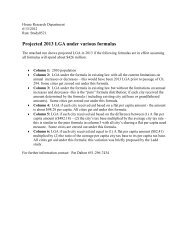Analyzing the Social Return on Investment in Youth Mentoring ...
Analyzing the Social Return on Investment in Youth Mentoring ...
Analyzing the Social Return on Investment in Youth Mentoring ...
You also want an ePaper? Increase the reach of your titles
YUMPU automatically turns print PDFs into web optimized ePapers that Google loves.
• This paper expla<strong>in</strong>s a framework for compar<strong>in</strong>g <str<strong>on</strong>g>the</str<strong>on</strong>g> dollar value of costs and benefitsof youth mentor<strong>in</strong>g programs <strong>in</strong> M<strong>in</strong>nesota. This framework can be used to calculate<str<strong>on</strong>g>the</str<strong>on</strong>g> social return-<strong>on</strong>-<strong>in</strong>vestment (SROI) of such programs.• The formal applicati<strong>on</strong> of this framework to estimate <str<strong>on</strong>g>the</str<strong>on</strong>g> SROI of a particularprogram would require ei<str<strong>on</strong>g>the</str<strong>on</strong>g>r data from a complete, scientific program evaluati<strong>on</strong> that<strong>in</strong>cluded an unmentored c<strong>on</strong>trol group or, at a m<strong>in</strong>imum, detailed c<strong>on</strong>temporaneousand follow-up data <strong>on</strong> program participants that could be compared to norms foryouth of similar age and background.• The applied practice of valu<strong>in</strong>g <str<strong>on</strong>g>the</str<strong>on</strong>g> benefits of youth programs (when sufficientoutcomes data is available) is a rapidly evolv<strong>in</strong>g field of <strong>in</strong>quiry. More and more of<str<strong>on</strong>g>the</str<strong>on</strong>g>se potential benefits can be <strong>in</strong>cluded <strong>in</strong> analyses as SROI analysis becomes morewidespread and as necessary data becomes available.• Based <strong>on</strong> very limited outcomes data available for M<strong>in</strong>nesota youth programs, <str<strong>on</strong>g>the</str<strong>on</strong>g>results of a few nati<strong>on</strong>al program evaluati<strong>on</strong>s, and c<strong>on</strong>servative assumpti<strong>on</strong>s <strong>in</strong> l<strong>in</strong>ewith <str<strong>on</strong>g>the</str<strong>on</strong>g> experience of M<strong>in</strong>nesota youth programs, we provide an SROI analysis of aficti<strong>on</strong>al composite representative mentor<strong>in</strong>g program. We estimate that:• Based <strong>on</strong> c<strong>on</strong>servative assumpti<strong>on</strong>s about outcomes and valuati<strong>on</strong>s, ourrepresentative program returns benefits of $2.72 for every dollar ofresources used.• The program returns $2.08 for every dollar of cost if <str<strong>on</strong>g>the</str<strong>on</strong>g> value of mentors’time is excluded from <str<strong>on</strong>g>the</str<strong>on</strong>g> estimated benefits.• The program returns $1.87 of public benefits (public cost sav<strong>in</strong>gs and<strong>in</strong>creased tax revenues) for every dollar actually spent <strong>on</strong> <str<strong>on</strong>g>the</str<strong>on</strong>g> program.• The actual returns for a particular program would depend <strong>on</strong> <str<strong>on</strong>g>the</str<strong>on</strong>g> outcomes andexpenses of that particular program. We believe that returns <strong>in</strong> <str<strong>on</strong>g>the</str<strong>on</strong>g> example presentedhere fairly represent <str<strong>on</strong>g>the</str<strong>on</strong>g> returns that are achievable for well-run, effective mentor<strong>in</strong>gprograms. In some cases, it is certa<strong>in</strong>ly possible that returns could be higher than<str<strong>on</strong>g>the</str<strong>on</strong>g>se examples, especially when a program deals with very high-risk populati<strong>on</strong>s.• To produce more accurate and detailed analyses of <strong>in</strong>dividual programs, moredetailed data <strong>on</strong> program participants will need to be kept <strong>in</strong> order to measure anddocument juvenile and adult outcomes more precisely. This data collecti<strong>on</strong> could<strong>in</strong>clude an <strong>in</strong>termediate-term (5- to 10-year) l<strong>on</strong>gitud<strong>in</strong>al study of participants andsimilar youth who do not participate <strong>in</strong> mentor<strong>in</strong>g programs.SROI of <strong>Youth</strong> Mentor<strong>in</strong>g Programs 2 Wilder Research, March, 2007



